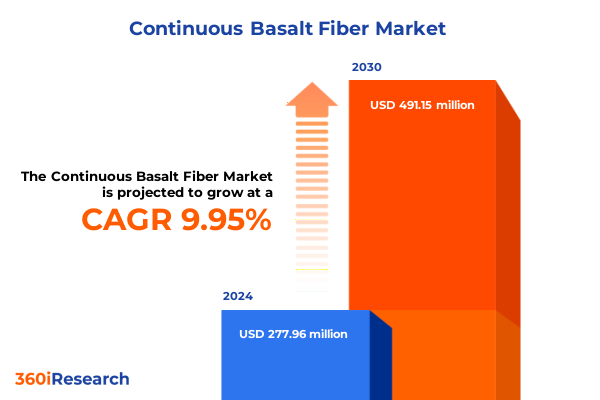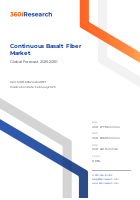The Continuous Basalt Fiber Market size was estimated at USD 277.96 million in 2024 and expected to reach USD 306.95 million in 2025, at a CAGR 9.95% to reach USD 491.15 million by 2030.

Introduction to Continuous Basalt Fiber: Unleashing Durable, Sustainable Reinforcement
Continuous basalt fiber emerges as a high-performance reinforcement material engineered from volcanic rock. With inherent resistance to corrosion, extreme temperatures, and chemical degradation, it offers a compelling alternative to traditional glass and carbon fibers. This round, continuous filament delivers exceptional tensile strength, dimensional stability, and superior durability in harsh environments. As industries demand lighter, stronger, and more sustainable composites, continuous basalt fiber has gained momentum across multiple manufacturing processes, applications, and end markets. Its eco-friendly profile-requiring minimal energy to produce and boasting recyclability-aligns with global decarbonization targets. This introduction sets the stage for an in-depth exploration of the forces reshaping its adoption, the impact of evolving tariffs, and actionable strategies for industry leaders.
Transformative Shifts Redefining Continuous Basalt Fiber Adoption
Recent years have witnessed transformative shifts in the continuous basalt fiber landscape. Advances in production methods such as filament winding, prepreg processing, pultrusion, and textile conversion have enhanced filament quality and process speed. Digitalization and Industry 4.0 integration have optimized supply chains, enabling real-time monitoring and predictive maintenance across manufacturing lines. Sustainability initiatives are accelerating: manufacturers are refining thermoplastic resin systems like nylon and polyurethane and fine-tuning thermoset matrices including epoxy and polyester resins to unlock new performance benchmarks. Regulatory frameworks targeting emissions and lightweighting have created fertile ground for basalt fiber applications in critical sectors. Meanwhile, end users in aerospace and defense, automotive exterior and interior components, construction reinforced concrete and structural parts, and marine decks and hulls are driving diversification. These cumulative innovations are redefining market boundaries and setting fresh performance standards.
Assessing the Cumulative Impact of United States Tariffs in 2025 on Supply Chains
The 2025 tariffs imposed by the United States have reshaped global basalt fiber supply chains. Increased duties on imported raw basalt and finished continuous filaments led to cost escalation for domestic processors and end users. Many manufacturers responded by reshoring operations or sourcing from alternative producers in Asia-Pacific and Europe. This reconfiguration has driven strategic alliances and joint ventures to secure feedstock and enhance local production capacity. In aerospace and defense, where supply chain security is paramount, firms are pursuing dual sourcing strategies to mitigate exposure to tariff volatility. Automotive and construction segments face higher component costs, prompting a shift toward unidirectional and woven basalt fiber solutions with optimized resin compatibility to maintain margins. Overall, the tariffs have spurred supply chain diversification, tactical pricing adjustments, and a push toward vertically integrated production models.
Key Segmentation Insights Driving Market Diversification
Deep segmentation analysis reveals how continuous basalt fiber applications and manufacturing techniques intersect to unlock targeted growth pathways. Across manufacturing processes-filament winding, prepreg processing, pultrusion, and textile conversion-each method drives specific end-product characteristics, whether it’s the high stiffness required in structural aerospace parts or the intricate weaves demanded by sporting goods like bicycles and skiing equipment. In aerospace and defense, basalt fiber is deployed in interior components and structural parts, capitalizing on its thermal stability and impact resistance. Automotive sectors leverage exterior components such as body panels and bumpers alongside interior components that benefit from lighter, flame-retardant materials. Construction applications encompass reinforced concrete and structural components, where woven or unidirectional basalt textiles enhance load-bearing capacity and corrosion resistance. In electrical and electronics, mesh and cables provide electromagnetic shielding, while marine decks and ship hulls utilize roving and yarn fiber types for superior fatigue performance. End users in wind energy exploit bars for turbine blade stiffening, and sports equipment benefits from the precise filament control of pultruded rods. Material engineers select between fabric, unidirectional, and woven types and tailor resin systems from thermoplastic options like nylon and polyurethane to thermoset epoxies and polyesters for optimal performance. The choice of fiber form-bars, cables, or mesh-further refines mechanical and electrical properties, enabling designers to meet stringent application requirements. This granular segmentation underscores the versatility of continuous basalt fiber and highlights actionable avenues for customized product development and market entry.
This comprehensive research report categorizes the Continuous Basalt Fiber market into clearly defined segments, providing a detailed analysis of emerging trends and precise revenue forecasts to support strategic decision-making.
- Manufacturing Process
- Application
- End User
- Type
- Resin Type
- Fiber Type
- End Product
Regional Dynamics Shaping Continuous Basalt Fiber Demand
Regional dynamics play a pivotal role in continuous basalt fiber adoption. In the Americas, robust demand from automotive lightweighting initiatives and burgeoning wind energy farms fuels investment in local production and R&D. Companies are scaling facilities to support pultrusion and textile processes that feed into domestic infrastructure and sports equipment markets. The Europe, Middle East & Africa region is characterized by stringent environmental regulations and strong aerospace activity, prompting manufacturers to refine epoxy and polyester resin formulations for high-temperature applications. Strategic ports in the Middle East serve as distribution hubs for marine and construction products, while North African producers explore roving and yarn exports. Asia-Pacific leads in production capacity, driven by low-cost feedstock from basalt-rich regions and government incentives for strategic materials. Automotive OEMs in China and India integrate basalt fiber into bumpers and body panels to meet aggressive fuel-efficiency targets, while South Korean electronics firms deploy continuous basalt fiber meshes for EMI shielding. These regional patterns underscore the importance of tailored strategies to navigate regulatory landscapes, cost structures, and application-specific demand.
This comprehensive research report examines key regions that drive the evolution of the Continuous Basalt Fiber market, offering deep insights into regional trends, growth factors, and industry developments that are influencing market performance.
- Americas
- Asia-Pacific
- Europe, Middle East & Africa
Leading Players and Their Strategic Footprints in Basalt Fiber
Leading companies are forging competitive advantages through innovation, capacity expansion, and strategic partnerships. Arab Basalt Fiber Company focuses on high-volume textile process output for construction mesh solutions, while Armbasalt CJSC leverages its European logistics network to supply structural aerospace components. Arrow Technical Textiles Pvt. Ltd. distinguishes itself in automotive interior parts with proprietary prepreg systems, and Fiberbas Construction and Building Technologies integrates roving fibers into reinforced concrete offerings. Final Advanced Materials emphasizes research into nylon–basalt composites, whereas Hengdian Group and HG GBF Basalt Fiber Co., Ltd. scale large-format pultruded bars for wind-turbine applications. Isomatex S.A. leads in thermoset resin research, complemented by Jilin Tongxin Basalt Technology Co., Ltd.’s advancements in filament winding efficiency. Kamenny Vek and LAVAintel collaborate on high-temperature epoxies, and Sudaglass Fiber Technology focuses on electrical and electronics meshes. Technobasalt, The Basaltex NV, and The Materials Group drive global distribution and service offerings, ensuring seamless integration of fabric, unidirectional, and woven basalt fiber across end-user segments.
This comprehensive research report delivers an in-depth overview of the principal market players in the Continuous Basalt Fiber market, evaluating their market share, strategic initiatives, and competitive positioning to illuminate the factors shaping the competitive landscape.
- Arab Basalt Fiber Company
- Armbasalt CJSC
- Arrow Technical Textiles Pvt. Ltd.
- Fiberbas Construction and Building Technologies
- Final Advanced Materials
- Hengdian Group
- HG GBF Basalt Fiber Co., Ltd.
- Isomatex S.A.
- Jilin Tongxin Basalt Technology Co., Ltd.
- Kamenny Vek
- LAVAintel
- Sudaglass Fiber Technology
- Technobasalt
- The Basaltex NV
- The Materials Group
Actionable Recommendations for Industry Leaders to Capitalize on Emerging Opportunities
To capitalize on emerging opportunities, industry leaders should pursue five strategic imperatives. First, establish cross-sector partnerships to co-develop tailored resin–fiber systems, leveraging thermoplastic and thermoset expertise for niche applications. Second, diversify supply chains to mitigate tariff and geopolitical risks by combining domestic production with selective imports and joint ventures in Asia-Pacific and Europe. Third, invest in digital manufacturing platforms that integrate filament winding, prepreg processing, pultrusion, and textile conversion for real-time quality control and cost optimization. Fourth, target high-value end markets-such as aerospace structural parts, wind-turbine bars, and marine hulls-through dedicated product lines that highlight continuous basalt fiber’s sustainability and performance benefits. Finally, enhance after-sales support and training programs for downstream converters and end users, fostering long-term customer loyalty and accelerating adoption in emerging applications such as electrical shielding meshes and reinforced concrete components.
Explore AI-driven insights for the Continuous Basalt Fiber market with ResearchAI on our online platform, providing deeper, data-backed market analysis.
Ask ResearchAI anything
World's First Innovative Al for Market Research
Conclusion: Positioning for Growth in a Dynamic Material Landscape
Continuous basalt fiber stands at the crossroads of material innovation and market transformation. Recent advances in manufacturing, diversified segmentation, and regional growth dynamics have established it as a versatile solution across aerospace, automotive, construction, marine, and sporting goods sectors. Despite the headwinds of U.S. tariffs, the industry has demonstrated resilience by optimizing supply chains and refining resin compatibility. As companies refine processes and expand into new geographies, continuous basalt fiber is poised to meet the dual demands of performance and sustainability, driving competitive advantage for forward-thinking organizations.
This section provides a structured overview of the report, outlining key chapters and topics covered for easy reference in our Continuous Basalt Fiber market comprehensive research report.
- Preface
- Research Methodology
- Executive Summary
- Market Overview
- Market Dynamics
- Market Insights
- Cumulative Impact of United States Tariffs 2025
- Continuous Basalt Fiber Market, by Manufacturing Process
- Continuous Basalt Fiber Market, by Application
- Continuous Basalt Fiber Market, by End User
- Continuous Basalt Fiber Market, by Type
- Continuous Basalt Fiber Market, by Resin Type
- Continuous Basalt Fiber Market, by Fiber Type
- Continuous Basalt Fiber Market, by End Product
- Americas Continuous Basalt Fiber Market
- Asia-Pacific Continuous Basalt Fiber Market
- Europe, Middle East & Africa Continuous Basalt Fiber Market
- Competitive Landscape
- ResearchAI
- ResearchStatistics
- ResearchContacts
- ResearchArticles
- Appendix
- List of Figures [Total: 30]
- List of Tables [Total: 684 ]
Call to Action: Secure In-Depth Insights with Our Expert Team
To gain comprehensive insights and actionable data on continuous basalt fiber trends, segmentation, regional dynamics, and competitive intelligence, contact Ketan Rohom (Associate Director, Sales & Marketing) to purchase the full market research report.

- How big is the Continuous Basalt Fiber Market?
- What is the Continuous Basalt Fiber Market growth?
- When do I get the report?
- In what format does this report get delivered to me?
- How long has 360iResearch been around?
- What if I have a question about your reports?
- Can I share this report with my team?
- Can I use your research in my presentation?




